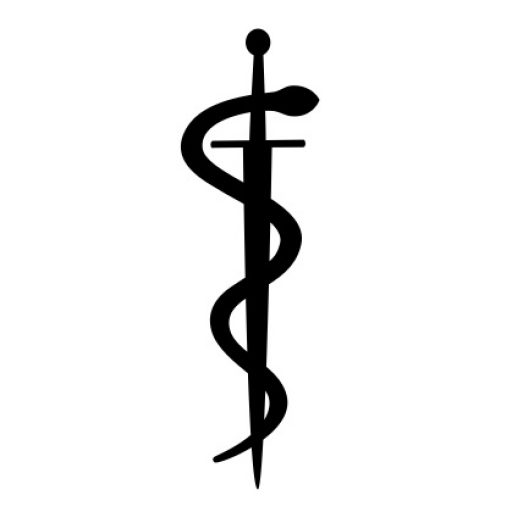French 1854 Cuirassier - Notes from a New Collector
Feb 25, 2017 6:17:34 GMT
Post by Afoo on Feb 25, 2017 6:17:34 GMT
A while back, Pino did a post about Cuirassier Swords inspired by the French ANIX system.
I have always shied away from these swords, since I assumed that they would be expensive - French Swords command a premium, and French Cuirassier swords even more so. Any one which fell within my price range would likely be rubbish.....
Recently however, I was able to get an example from Pino. In particular, I was able to pick up the EXACT same 1854 sword that he featured in his article, which I thought was neat.
Having never handled this type of sword before, I figure I would write down some notes and impressions - hopefully it will foster some discussion. At the very least it will give new collectors like myself an idea of what to expect from this family of swords, as nothing really compares to them.
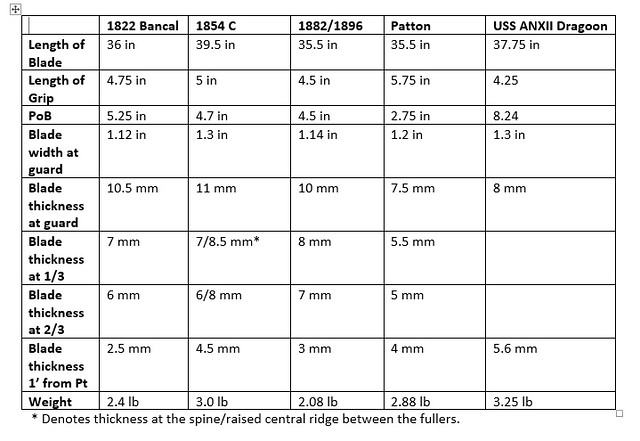
Table of data. Here I compare the 1854 to its immediate predecessor (the 1822 Bancal) and its immediate successor (the 1882 model). I also compare it to the 1913 Patton sword, and to a Universal Swords replica of the French ANXII sword for context. **
To the uninitiated such as myself, it is tempting to compare the 1854 to the US Patton sabre. Both are relatively heavy, broad double-edged hand lances. This is really not a good comparison. The Patton is not what you would call a small sword, but the 1854 dwarfs it, being a whole 4 inches longer. The blade of the 1854 is also much thicker, contributing to the 10% mass increase. In the hands the 1854 definitely feels heavier than the Patton, though at least some of this can be attributed to the later's ergonomic grips rather purely differences in blade geometry. The Patton has some moderate flex, whereas the 1854 has less flex than Margaret Thatcher.
Part of this is due to the blade geometry. The two fullers lend stiffness. Moreover, the area between the fullers actually forms a raises ridge. As you can see from the table, this central ridge is even thicker than the spine of the blade. This design is clever, as the central location of the ridge ensures that any force applied to the tip of the blade is transferred straight back, rather than at an offset.
Funnily, My Preval bladed cavalry sword is still stiffer than the 1854, despite all the extra mass and the complex blade geometry. The Preval is shorter so that's not a quantitative comparison, but it does go to show the benefits of the Preval blade design.
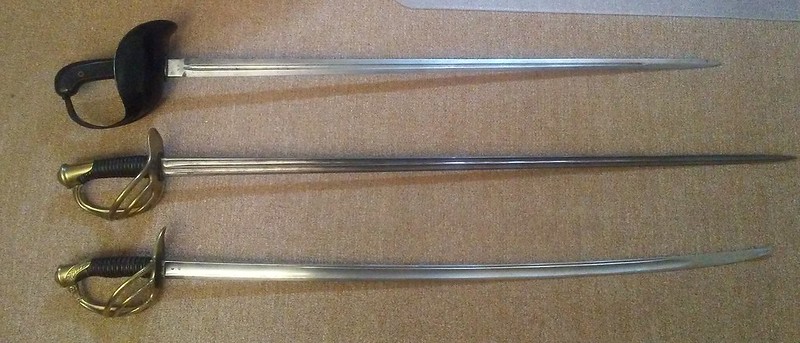
Image of the 1854 (middle) compared to the 1822 Bancal (bottom) and the 1913 Patton (Top)
Looking back to its predecessor, the Bancal is a good sword in its own right, and I never really understood why it was given up...until I got the 1854. The 1854 has much more presence and authority. It is much less maneuverable in close, but I can see its appeal to troopers accustomed to the impact and shock of heavy cavalry action. Despite outward similarities, the guard on the 1854 is larger than that of the Bancal, or at least the officers version I have available.
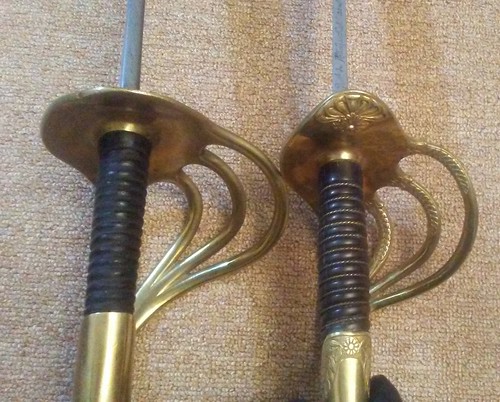
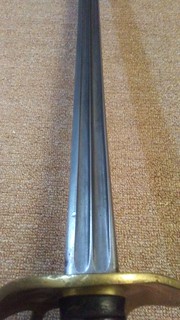
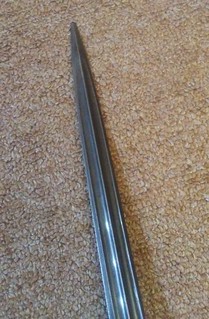
Guard of the 1854 (left) and Bancal (right). FIgure showing the raised ridge in between the two fullers. Raised ridge goes all the way to the point
All in all, the 1854 is....an interesting sword. The handling is good for a 3 lb sword - the blade geometry and large guard helps keep weight close to the hand, and the grips are comfortable and give good support....but here are livelier swords out there. Even if you want a hand-lance, there are better options for handling - the Patton or the French 1882 for example. To fully appreciate the 1854 you have to look at it not only as a sword, but as a piece of history and as a work of art. It has an imposing beauty to it, much the same as Mt Rushmore or the Coast Redwoods. To be able to hold such power in your hands is quite an experience. Gain, nobody out there would call the Patton a small sword, but yet this thing dwarfs it without becoming completely unmanageable.
~~
One issue I have with the sword concerns markings. The markings themselves are fine, but I just cannot interpret them. I think its a Chat. Manufacture in the year of 1864, but I am not certain. Any help would be appreciated. Link to full-sized images here flic.kr/s/aHskSykUj3

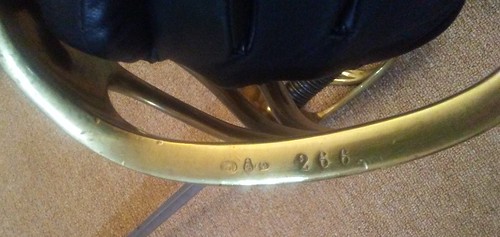
**The 1822 Bancal in my collection is an officers version, discussed here. Its shorter than the standard troopers version and the guard is a bit different. However, its the closest example I have. The 1882 model is represented by my 1882/1896 model discussed here. This is an 1882 blade remounted on an 1896 hilt. This may lead to some differences in the stats, but again its the closest analogue I have. As such, the stats for these swords may not be reflective of the "official" pattern
I have always shied away from these swords, since I assumed that they would be expensive - French Swords command a premium, and French Cuirassier swords even more so. Any one which fell within my price range would likely be rubbish.....
Recently however, I was able to get an example from Pino. In particular, I was able to pick up the EXACT same 1854 sword that he featured in his article, which I thought was neat.
Having never handled this type of sword before, I figure I would write down some notes and impressions - hopefully it will foster some discussion. At the very least it will give new collectors like myself an idea of what to expect from this family of swords, as nothing really compares to them.

Table of data. Here I compare the 1854 to its immediate predecessor (the 1822 Bancal) and its immediate successor (the 1882 model). I also compare it to the 1913 Patton sword, and to a Universal Swords replica of the French ANXII sword for context. **
To the uninitiated such as myself, it is tempting to compare the 1854 to the US Patton sabre. Both are relatively heavy, broad double-edged hand lances. This is really not a good comparison. The Patton is not what you would call a small sword, but the 1854 dwarfs it, being a whole 4 inches longer. The blade of the 1854 is also much thicker, contributing to the 10% mass increase. In the hands the 1854 definitely feels heavier than the Patton, though at least some of this can be attributed to the later's ergonomic grips rather purely differences in blade geometry. The Patton has some moderate flex, whereas the 1854 has less flex than Margaret Thatcher.
Part of this is due to the blade geometry. The two fullers lend stiffness. Moreover, the area between the fullers actually forms a raises ridge. As you can see from the table, this central ridge is even thicker than the spine of the blade. This design is clever, as the central location of the ridge ensures that any force applied to the tip of the blade is transferred straight back, rather than at an offset.
Funnily, My Preval bladed cavalry sword is still stiffer than the 1854, despite all the extra mass and the complex blade geometry. The Preval is shorter so that's not a quantitative comparison, but it does go to show the benefits of the Preval blade design.

Image of the 1854 (middle) compared to the 1822 Bancal (bottom) and the 1913 Patton (Top)
Looking back to its predecessor, the Bancal is a good sword in its own right, and I never really understood why it was given up...until I got the 1854. The 1854 has much more presence and authority. It is much less maneuverable in close, but I can see its appeal to troopers accustomed to the impact and shock of heavy cavalry action. Despite outward similarities, the guard on the 1854 is larger than that of the Bancal, or at least the officers version I have available.



Guard of the 1854 (left) and Bancal (right). FIgure showing the raised ridge in between the two fullers. Raised ridge goes all the way to the point
All in all, the 1854 is....an interesting sword. The handling is good for a 3 lb sword - the blade geometry and large guard helps keep weight close to the hand, and the grips are comfortable and give good support....but here are livelier swords out there. Even if you want a hand-lance, there are better options for handling - the Patton or the French 1882 for example. To fully appreciate the 1854 you have to look at it not only as a sword, but as a piece of history and as a work of art. It has an imposing beauty to it, much the same as Mt Rushmore or the Coast Redwoods. To be able to hold such power in your hands is quite an experience. Gain, nobody out there would call the Patton a small sword, but yet this thing dwarfs it without becoming completely unmanageable.
~~
One issue I have with the sword concerns markings. The markings themselves are fine, but I just cannot interpret them. I think its a Chat. Manufacture in the year of 1864, but I am not certain. Any help would be appreciated. Link to full-sized images here flic.kr/s/aHskSykUj3


**The 1822 Bancal in my collection is an officers version, discussed here. Its shorter than the standard troopers version and the guard is a bit different. However, its the closest example I have. The 1882 model is represented by my 1882/1896 model discussed here. This is an 1882 blade remounted on an 1896 hilt. This may lead to some differences in the stats, but again its the closest analogue I have. As such, the stats for these swords may not be reflective of the "official" pattern




